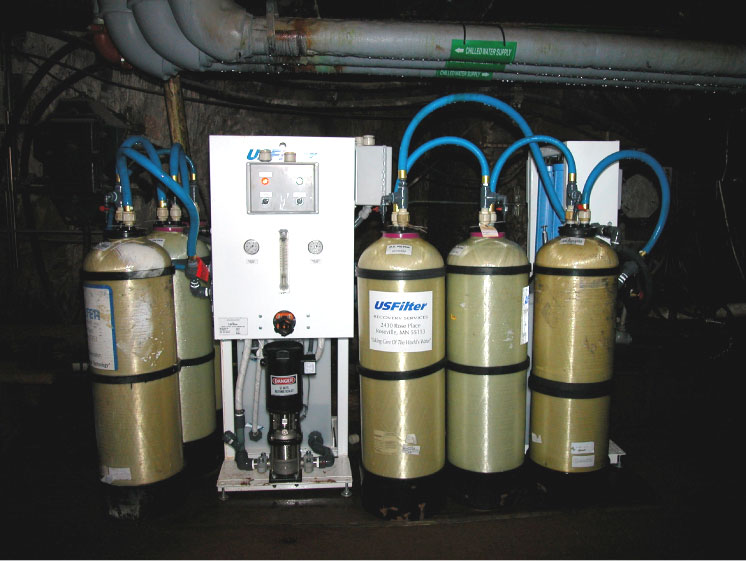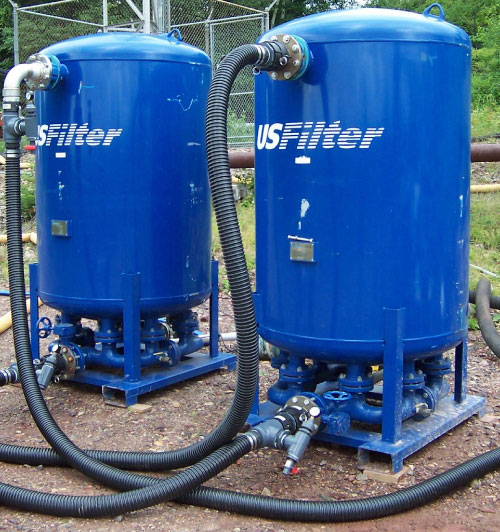Technology Overview as part of a Web-based Technical and Regulatory Guidance
Ion Exchange
1. Introduction
Click Here to view case
study table at the end of this document.
![]()
Ion exchange involves the interchange (or exchange) of ions between
a solid media and mining-influenced water (MIW). The solid media can be commercially
produced or made from naturally occurring substances (e.g., peat or zeolites).
Various resin forms are available to remove either cations or anions. Synthetic
organic resins are the predominant type since their characteristics can be
tailored to specific applications.
2. Applicability
Ion exchange can be applied in the
following ways:
- to dissolved constituents
- to cations or anions
- to treat mine discharges with various flow rates
- as stand-alone technology or in combination with others
Ion exchange media needs to be selected based on the MIW chemistry and the specific parameters that need to be removed from solution. Tests are required to select an appropriate resin. Large flows generally require a full-scale treatment plant, but for small to intermediate flows, standard tank sizes are available that allow systems to be set up quickly.
In general, ion exchange works best for waters in the pH range of 4–8 with low suspended solids and low concentrations of Fe and Al. The more complex the mixture, the harder it is to remove all metals effectively. Resins can be designed to target specific groups (e.g., trace metals), but within these groups there is a hierarchy of removal. For example, the typical preference for cations on strong acid resins is as follows:
Pb2+ > Ca2+ > Ni2+ > Cd2+ > Cu2+ > Zn2+ > Mg2+ > K+ > NH4+ > Na+ > H+
And the typical preference for anions on strong base resins:
SO42– > NO3– > Cl– > OH–
At the Soudan Mine in northern Minnesota, a selective cation exchange resin was used to remove copper and cobalt from two different mine drainages. The first drainage is within the mine and had a pH of 4 with flow ranging about 1–10 gpm, copper 3–30 mg/L, and cobalt 0.1–0.3 mg/L. The second drainage is the entire discharge from the mine. This water is circumneutral with a flow rate of 150–300 gpm and copper and cobalt ranging 50–200 µg/L and 10–20 µg/L, respectively. Tests have been conducted using commercial resins and lower-cost exchange material produced from peat (Eger, Paulson, Green 2008; Eger et al. 2009).
At the Schwartzwalder Mine in Colorado, resins were used to recover uranium from mining and metallurgical processes (Zielinski et al. 2008). Other tests of ion exchange with mining influenced waters are referenced in Gusek and Figueroa (2009).
3. Advantages
Advantages of ion exchange include the
following:
- temporary or permanent applications
- immediate results
- standard tank sizes available for small to intermediate flows, which allow quick installation
- minimal maintenance with standard size tank systems
- waste disposal able be handled by supplier
- capable of meeting low-level discharge permit requirements
Ion exchange resins are available in standard size tanks that can be delivered and set up on site. For these systems, a permanent shelter is not required, but the tanks must not freeze. Power is needed to pump water through the resin, but this could be supplied by a generator. Resin tanks used at Soudan range from 3.7 ft3 to 60 ft3 (Figures 3-1 and 3-2).

Figure 3-1. In-mine ion exchange treatment, Soudan Mine. (3.7 ft3 tanks)
Once operational, the tanks can treat water until the exchange capacity is exhausted. Site-specific capacities can be developed and used to schedule tank replacement. The removed substance must be chemically stripped from the resin. In general, an acid is used to remove trace metals from the resin, and sometimes these metals can be recovered. Currently, the volume of resin from Soudan is too small to regenerate separately, so it is mixed with other resins. Recovered metals at the Soudan treatment site are used as a granular additive for cement. In general, depending on metal concentration, form, and the solidification process, additional treatment of disposal options will need to be considered for the extracted metal waste product.

Figure 3-2. Ion exchange resin tanks (60 ft3), Soudan Mine.
4. Limitations
Limitations of ion exchange include
the following:
- chemical characteristics of the influent mine water
- generally not effective for low pH
- generally not effective for high concentrations Fe, Mn, Al
- generally not effective for complex mixtures of metals
- suspended solids need to be removed prior to treatment
- resin regeneration
- resin fouling
- ongoing operational cost
Prefiltration is generally recommended prior to treatment through the resin and pH may need to be adjusted. The presence of iron and aluminum complicates treatment since they can form precipitates and plug or coat (armor) the resin. High concentrations of aluminum within the Soudan Mine caused plugging of the in-mine resin tanks and required a bank of prefilter units. These prefilters need to be changed at least twice per week.
The overall Soudan discharge is currently filtered with bag and cartridge filters to a nominal 1 µm size to avoid plugging the large resin tanks with fine suspended iron. Filter maintenance and replacement in addition to tank rental and resin regeneration have significant costs.
5. Performance
At the Soudan Mine, once startup problems were resolved, the ion exchange
system has been effective in removing metals from the level within the mine
for four years. Removal efficiencies are generally over 95% and often exceed
99%. Startup problems were the result of an unexpected aluminum precipitate,
which plugged the resin tanks (Eger 2007). Removal efficiency decreases as
the capacity of the resin is approached or the resin becomes totally saturated.
Data for treatment of the entire discharge are more limited. During the pilot test input, total copper ranged about 60–70 µg/L, filtered copper was around 10 µg/L, and total and filtered cobalt was on the order of 7–8 µg/L. Essentially all dissolved copper and cobalt were removed to less than the detection limit of 2 µg/l. The outflow did contain some suspended copper, but the total concentrations were below the permit limit of 17 µg/L (Eger et al. 2009).
A full-scale system was installed to treat the entire flow of 150 gpm from the mine. Preliminary data suggest that the resin tanks are removing some of the finely suspended copper as well as dissolved copper and cobalt. Initial samples met the required limits of 17 µg/L for total copper and 4 µg/L for total cobalt. Dissolved metals in subsequent samples continued to be below permit standards, but some samples contained small amounts of suspended copper, which caused the total value to exceed 17 µg/L.6. Costs
Ion exchange can be an expensive treatment option. Estimated annual costs
for the Soudan Mine discharge (average flow 60 gal/min) is around $150,000.
7. Regulatory Considerations
Ion exchange requires approvals and/or permits from one or more regulatory
authorities (federal, state, and/or local), depending on the applications
being proposed. It should also be noted that if any surface water is being
impacted, a National Pollutant Discharge Elimination System (NPDES) permit
may be required at the final point of discharge. Treatment of the Soudan
mine discharge was required by an NPDES permit under the Clean Water Act
and managed by the Minnesota Pollution Control Agency.
8. Stakeholder Considerations
Ion exchange is a well-accepted standard treatment technology capable of
meeting low-level discharge permit requirements. The ability to regenerate
resin and recover metals provides a potential additional benefit of this
approach.
9. Lessons Learned
Prevention of plugging of the resin by either chemical precipitates or suspended
solids is critical to maintain treatment. Since every water is different,
testing must be done to adequately select an appropriate resin. The available
resin capacity must be monitored carefully to ensure that adequate exchange
sites remain to provide treatment. A program to replace exhausted tanks is
critical to maintain continual performance.
Table 10-1. Case study using ion exchange
11. References
Eger, P. 2007. “Solving Mine Drainage Problems at Soudan State
Park—One Step Forward, Two Steps Back,” in Proceedings, 24th Annual
Meeting, American Society of Mining Reclamation, Gillette,
WY, June 3–8.
Eger, P., M. Olson, L. Peterson, J. Essig, G. Lunz, and D. Sobania. 2009. Alternative Technologies for Treating Mine Water Discharge at Soudan State Park. Minnesota Department of Natural Resources.
Eger, P., E. Paulson, and D. Green. 2008. “The Use of Peat Pellets to Remove Copper and Cobalt from Mine Drainage,” in Proceedings, 25th Annual Meeting, American Society of Mining Reclamation, Richmond, VA, June 14–19.
Gusek, J. J., and L. A. Figueroa, eds. 2009. Mitigation of Metal Mining Influenced Water, vol. 2. Society for Mining Metallurgy and Exploration.
Zielinski, R. A., J. K. Otton, R. R. Schumann, and L. Wirt. 2008. Uranium in Surface Waters and Sediments Affected by Historical Mining in the Denver West 1:100,000 Quadrangle, Colorado. U.S. Geological Survey Scientific Investigations Report 2007–5246.
